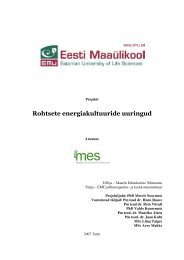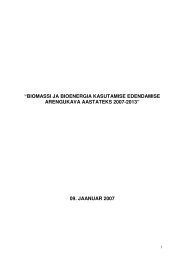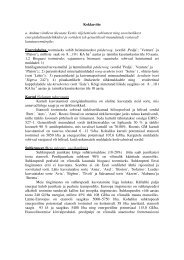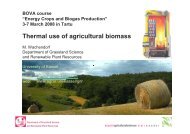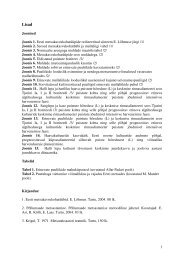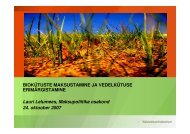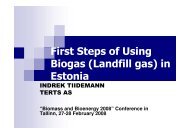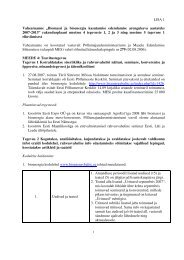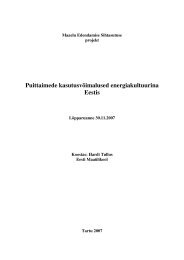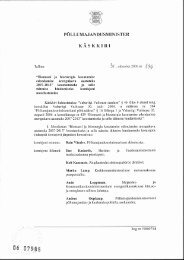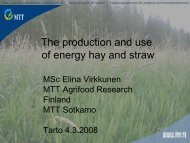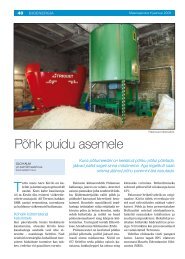Põllumajandusministeeriumi ja Maaelu ... - bioenergybaltic
Põllumajandusministeeriumi ja Maaelu ... - bioenergybaltic
Põllumajandusministeeriumi ja Maaelu ... - bioenergybaltic
You also want an ePaper? Increase the reach of your titles
YUMPU automatically turns print PDFs into web optimized ePapers that Google loves.
Areas of application of woody plants as energy crops in Estonia<br />
EXECUTOR: Estonian University of Life Sciences<br />
The survey must:<br />
1. Give a comparative overview of the types and varieties of energy crops (including<br />
genetically modified) recommended and suitable for growing in Estonia, according to the<br />
intended purpose;<br />
2. Analyse the equipment needed for growing energy crops and the location of agricultural<br />
technology, and the additional needs or the need to adjust the existing technology, keeping<br />
potential production volume in mind.<br />
3. Analyse and describe the effect of growing different energy crops on the fertility of the soil;<br />
4. Give an assessment to the suitability of and options for growing various energy crops by<br />
regions pursuant to the cross-compliance enforced within the common agricultural policy of<br />
the EU.<br />
5. Analyse the factors restricting and facilitating the growing of energy crops (including<br />
environmental requirements);<br />
6. Analyse the expected environmental impacts;<br />
7. Make suggestions for organizing a more wide-spread growing of energy crops in Estonia.<br />
Studies of the calorific energy value of various biomass fractions of different tree species<br />
collected earlier.<br />
The result must be an analysis that gives an overview of which crops it is possible and<br />
expedient to grow in specific circumstances, which environmental and agricultural technology<br />
requirements (including cross-compliance) need to be taken into account when growing,<br />
points out the factors restricting and facilitating the growing of energy crops and, if necessary,<br />
makes proposals for amending the official order (legal instruments, fiscal instruments, etc.) to<br />
facilitate the growing of energy crops to the recommended extent.<br />
Areas of application of woody plants as energy crops in Estonia<br />
Summary and conclusions<br />
1. There exists 300 000–400 000 ha of abandoned agricultural land in Estonia. One<br />
alternative use for such land is establishment of short rotation plantations with woody plants as<br />
energy crops. Afforestation of one third of abandoned agricultural land can be recommended,<br />
using mainly deciduous species and shorter rotations compared to traditional forestry.<br />
2. The main advantage of woody plants as energy crops on former agricultural land,<br />
compared to herbaceous energy crops (in case the seeds or whole above-ground part of the<br />
plant is converted to bio-energy), is the chemical wood composition. The concentration of<br />
ashes in the wood is 5–10 times lower compared to herbaceous plants and the main elements<br />
in wood are carbon, oxygen and hydrogen. The concentration of nutrients (NPK and others) in<br />
wood and bark is low and therefore the removal of biomass with harvest has only small<br />
negative impact on soil fertility and the consequent need for fertilization is not significant.<br />
3. The increase in area under short rotation forest plantations with fast growing tree<br />
species (plantation forestry) in Estonia corresponds to the general trend in the whole world.<br />
Plantation forestry has spread out from southern Europe and reached all countries in the Baltic<br />
Sea region, including South- and Central-Sweden and –Finland. The share of forest plantations<br />
constitutes 5–6% of the world forestland, but the share of commercial wood from plantations<br />
39




